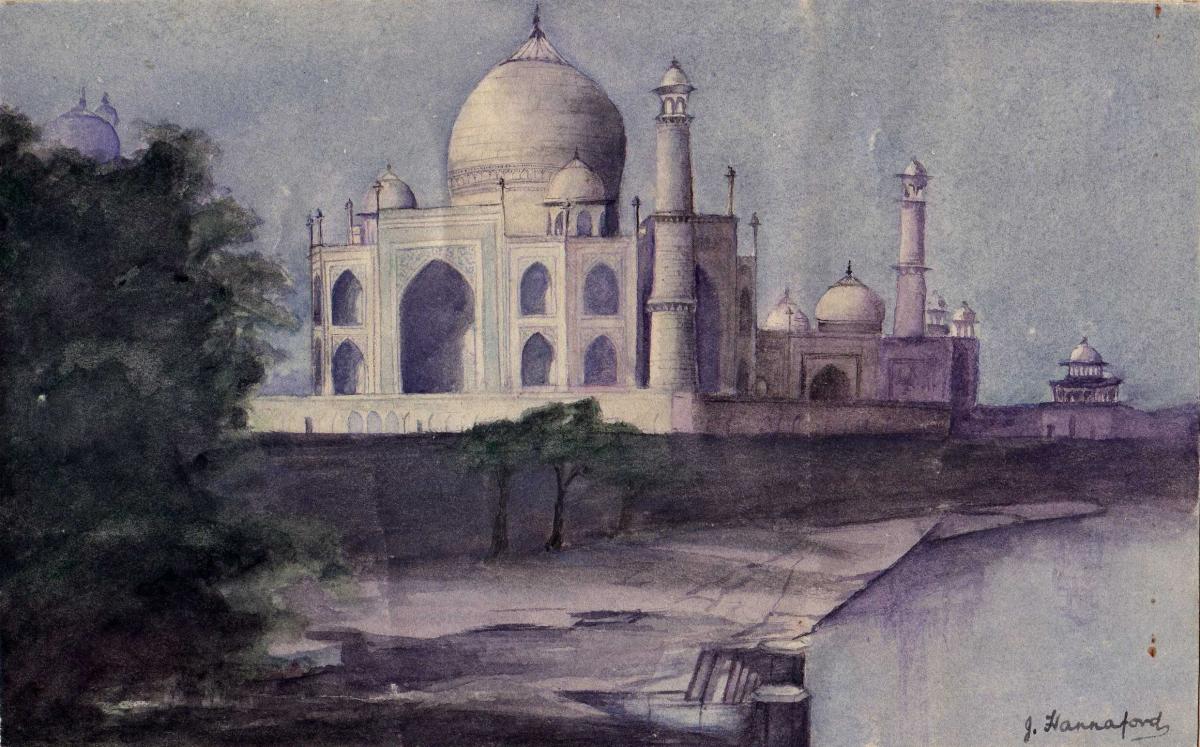|
“The morning was heavy with mist as we set off from Agra by bus for the Taj Mahal. What a disappointment that would be if the great monument remained only dimly visible against a grey sky. But as we neared the site the sun came out and there it was 213 ft (71 m) of shining white marble from plinth to dome”. This was Janet Sawyer’s first impression on seeing the Taj Mahal (figure 1) for the first time. The Mughal Empire, which encompassed most of the Indian continent, was established 100 years earlier than the building of the Taj Mahal by Babur when he defeated the Sultan of Delhi in 1526. Babur was a Timurid prince from Central Asia and a descendant of Genghis Kan. By the time Shah Jahan had become Emperor, the Empire had become fabulously wealthy. Mumtaz Mahal, Shah Jahan’s 3rd wife, was said to be a woman of great beauty and virtue and became the Shah’s constant companion and adviser as he travelled around his Empire. On her travels she was adorned with what has become immediately recognisable as Mughal jewellery (figure 2). So you may ask why I became interested in the Taj Mahal. It was one day a couple of years ago that I noticed behind a number of antiques in a cabinet, a small black marble box with a beautiful depiction of the Taj Mahal in mother–of–pearl inlaid into the lid, the mother–of–pearl coming from the Gold–lipped pearl oyster, Pinctada maxima Jameson 1901. The mother of pearl from which it was made had been carved, etched and engraved very delicately and was probably made in the early 1900’s (figure 3). The Taj Mahal is one of the world’s greatest monuments, a World Heritage site visited by 8 million pilgrims and tourists every year. It sits on the banks of the Jamuna river near Agra, the capital of the Mughal Empire. It was built of white marble using 20,000 labourers, stone masons, architects and 1000 elephants over a 21 year period from 1632 to 1653 as a mausoleum for Shah Jahan’s wife Mumtaz who died at 31 giving birth to her 14th child, Gauhara Begum. In order to console himself, Shah Jahan built the Taj Mahal in a design to symbolise their love. The main tomb is set in a traditional Islamic garden, a Charbagh, with formally laid out water features, and is flanked by a mosque and guest house. The Taj Mahal stands on a square podium with a minaret on each corner and has a central guava shaped dome with a gold crescent moon on top of the finial. The outer marble surfaces are covered with traditional Islamic decoration; swirling calligraphy of passages from the Qur’an. Inside is again white marble decorated with geometric patterns, motifs of plants and arabesques of intertwining leaves and vines. All is inlaid with semi–precious stones. Life is extraordinary sometimes! For twenty years I never saw nor found a Taj Mahal souvenir, but in the last few months I have seen and found several Taj Mahal souvenirs, hence the reason for this article. All have a mother−of −pearl Taj Mahal inlaid into so called “marble”. The first was a white dish owned by Eleanor Fogan (figure 4); a pity that the engraving was less well executed. Then I found a black plaque with again the Taj Mahal inlaid into it (figure 5). On closer examination I found that the plaque was made of a piece of slate painted black. And a week before writing this I found a brown soapstone dish with an extremely poor mother of pearl Taj Mahal inlaid into it and the finials simply dyed in red instead of painted in gold (figure 6). I suppose we should be pleased that stone masons in Agra are still using real stone and mother–of–pearl rather than selling plastic substitutes which have replaced so many of the handcrafted souvenirs from the past.
References For further information on the Taj Mahal, see http://en.wikipedia.org/wiki/Taj_Mahal Other references: Anon. 1973 The ‘Last Two thousand years’ – A new nation forged by the Mughal conquerors. Readers Digest History of Man. Anon. 2007 Landmarks of the World: The Taj Mahal. Bill Press. Jaitly, J. 1990 The Craft Traditions of India. The stone carver. Lustre Press.
Acknowledgements I would like to thank Janet Sawyer for allowing me to use unpublished notes of her visit to the Taj Mahal, which included information on the history and architecture of this wonderful monument. |
figure 1: A painting of the Taj Mahal by my mother (J. Hannaford before she was married) on a visit to India.
figure 2: Copy of Mughal jewellery. Earrings and brooch made of gold, red enamel and pearls. (Photo: John LLewellyn-Jones)
figure 3: Black marble box with inlaid mother of pearl. (Photo: John Llewellyn-Jones)
figure 4: Taj Mahal inlaid into white alabaster. (Photo: John Llewellyn-Jones) figure 5: Taj Mahal inlaid into painted slate. (Photo: John Llewellyn-Jones) figure 6: Taj Mahal inlaid into soapstone (Photo: John Llewellyn-Jones) |
History from a shell object (the Taj Mahal – India)
Issue
27
Page
24




